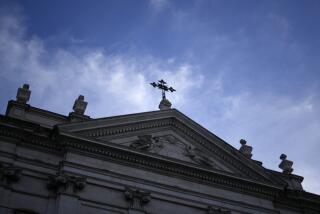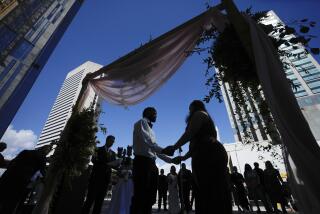Number of Nuns on Brink of Precipitous Drop
As Roman Catholic nuns approach the next century, a new nationwide survey confirms fears long voiced throughout the church: Nuns appear to be dying out as an institution.
In a survey of 1,049 sisters in the United States and Puerto Rico, The Times found that only 3% were 40 or younger; 37% were older than 70 and 12% were more than 80. The median age for nuns in the survey was 65.
“American Catholics have no idea how very soon there will be no nuns,” said Sister Patricia Wittberg, a church sociologist at Indiana University and at a Purdue University facility in Indianapolis, after reviewing The Times data.
Sister Eleace King, a research associate at the Center for Applied Research in the Apostolate at Georgetown University in Washington, concurred. “It tells me that the majority of religious congregations of women in this country will not survive. Most are dying,” King said.
The latest data comes at a time when the church has found a steady exodus of nuns, who in the first half of this century were a bulwark in the U.S. church and who continue to carry out its work.
In 1993--the latest year for which statistics are available--there were 94,022 nuns in the United States, compared to a peak of 181,421 in 1966. In 1988 there were 106,912.
Most younger nuns are in their 40s, the poll found.
“My generation--I’m a baby boomer--is disproportionately underrepresented, nuns between 35 and 50 years old,” Wittberg said. “That’s one generation next to missing. The next generation, the baby busters, is missing. That’s two whole generations that are not there.”
As their numbers have decreased, the work falls on older women, the poll found. More than two of five nuns (43%) in their 70s were not yet fully retired. And although 88% of nuns in their 80s say they are mostly retired, 13% were still involved in some form of community service.
Asked their occupations, a 29% plurality of women religious reported that they are retired, and one in four named education as their primary assignment. Eighteen percent were administrators, 13% were in community service and 11% in health care.
Experts differ on why young women are not joining religious orders. The Rev. Andrew W. Greeley, a Catholic sociologist, speculated about several possibilities in his book, “The Catholic Myth.” They include a sense of oppression in the communities, or the “emancipation” of the orders that led to a removal of the rigid life that appealed to some members.
Perhaps, Greeley added, younger women no longer saw anything in the vocations of nuns that could not be achieved in lay ministries (even though women religious are technically part of the laity).
Whatever the case, The Times found that among those who are nuns, 87% were satisfied with their lives and 60% indicated their lives are better than they anticipated. Almost none say their lives are worse. Indeed, 88% of nuns (and 87% of priests) said they would definitely or probably enter their professions again if they had to make the choice. And more than nine in 10 nuns (92%) said it is very unlikely they will ever abandon their vocation.
A majority of nuns would favor ordination of women as priests, but few of them would take the church up on the offer--89% of nuns said they would not seek to become priests if the church allowed it. Just 7% of all nuns--and 5% of those dissatisfied with their lives--probably or definitely would seek ordination. Among nuns 50 or younger, 15% would seek ordination, as would 13% of nuns who described themselves as liberals.
In another measure of satisfaction, 85% of nuns said they are comfortable going to the superiors of their orders for counsel and guidance. A nearly identical 86% said other sisters they meet regularly provide support for their vocations.
The superiors of the orders also received very high approval ratings (87% approved, 11% disapproved) from the sisters. A majority of 82% said their superiors’ moral views were just about right.
When it comes to the larger church, however, nuns are more critical. By 55% to 41%, sisters call the church’s ministry to lay women inadequate rather than adequate. When nuns were asked to name the most important problems facing the church in the United States today, sexism and a male-dominated clergy was the second most common response (by 18%), just behind the shortage of clergy and nuns (22%).
Interestingly, nuns felt their status in the church was a little better than how priests saw them. Forty-nine percent of priests called the status of nuns not so good or poor; 52% of nuns spoke positively of their status.
“Very often priests will come off more liberal than women on those things. That’s very typical,” said Wittberg. She also noted that most nuns are older. “If you admitted your extreme powerlessness,” Wittberg said, “you’d be admitting your whole life was a waste.”
Wittberg also offered another theory. When today’s elderly nuns were in their prime in pre-Vatican II days, they were in charge of schools and hospitals and had little contact with priests.
“If most priests knew what was good for them, they didn’t interfere,” she said. “It’s very possible that a lot of older women, honest to God, did not, in their life, experience an inferior position in the church. . . . A lot of these women never felt powerless.”
Forty-six percent of priests and 53% of nuns consider the church weaker than it was 30 years ago, even though at least three in five of both groups felt that changes initiated by the Second Vatican Council during the 1960s helped the church. A sizable minority (36% for nuns and 28% for priests) said the Vatican II reforms have been a mixed blessing. Among the actions that came out of Vatican II was greater emphasis on the role of rank-and-file Catholics.
There is an ideological dimension to the level of content or discontent in both priests and nuns, Brennan said, with liberals more unhappy over the church’s status than moderates or conservatives.
Nuns are particularly divided by ideology: Just 32% of religious liberals said the church is in good shape, and twice as many (44% versus 20%) said it is getting weaker today than stronger.
Nearly three of five conservative nuns said things in the church are good, and 39% thought things are improving rather than getting worse (23%). Younger sisters (age 50 or younger) were far more likely to rate church affairs in poor shape than are sisters over the age of 70. Twice as many younger nuns thought things in the church are getting worse rather than better (41% versus 19%). Among sisters over 70, the “better” group exceeded the “worse,” 35% to 20%.
More to Read
Start your day right
Sign up for Essential California for news, features and recommendations from the L.A. Times and beyond in your inbox six days a week.
You may occasionally receive promotional content from the Los Angeles Times.






